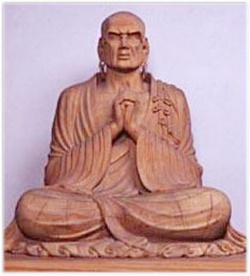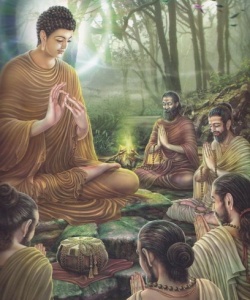Difference between revisions of "Alaya-vijnana"
| Line 107: | Line 107: | ||
The same [[idea]] is conveyed by the expression [[alayasamugghata]] - '[[uprooting of Alaya]]' - which is used in the [[Pali Canon]] as a {{Wiki|synonym}} for [[Nirvana]]. | The same [[idea]] is conveyed by the expression [[alayasamugghata]] - '[[uprooting of Alaya]]' - which is used in the [[Pali Canon]] as a {{Wiki|synonym}} for [[Nirvana]]. | ||
| − | Here it should be remembered, too, that [[analaya]], '[no-Alaya]]', is another {{Wiki|synonym}} for [[Nirvana]]. | + | Here it should be remembered, too, that [[analaya]], '[[no-Alaya]]', is another {{Wiki|synonym}} for [[Nirvana]]. |
The [[alayavijnanaparavrtti]] is sometimes called [[bijaparavrtti]] - '[[revolution of the seeds]]' - as well. | The [[alayavijnanaparavrtti]] is sometimes called [[bijaparavrtti]] - '[[revolution of the seeds]]' - as well. | ||
Latest revision as of 15:08, 18 March 2016
Alaya (S): Abbreviation of Alaya-vijanana.
A division of the mind into eight Consciousness was introduced by the Yogacara schools.
Alaya is considered the eighth, a sort of ground or eternal matrix, a storehouse of creativity containing all karmic traces and phenomenal possibilities; ultimately,
it is transpersonal and is the receptacle or totality of Consciousness both absolute and relative.
In the Yogacara school it is described as the fundamental mind or ground Consciousness of Sentient beings, which underlies the experience of individual Life, and which stores the germs of all future affairs.
It is the eighth Consciousness which transforms into Mirror-like Wisdom.
In the Yogacara (Vijnanavada) School of Buddhism, Alayavijnana is one of the most important doctrines developed by Asanga (fourth century A.C.).
He divides the vijnanaskandha (Aggregate of Conciousness) the fifth of the Five Skandhas, into three different aspects or layers, namely, Citta, manas and Vijnana.
In the Theravada Tipitaka as well as in the Pali Commentaries, these three terms - Citta, manas, Vijnana - are considered as synonyms denoting the same thing.
The Sarvistivada also takes them as synonyms.
Even the Lankavatara sutra, which is purely a Mahayana text, calls them synonyms although their separate functions are mentioned elsewhere in the same Sutra.
Vasubandhu, too, in his Vimsatikavijnapti-matratasiddhi considers them as synonyms.
Since any one of these three terms - Citta, manas, vijnanas - represents some aspect, even though not all aspects, of the fifth Aggregate vijnanaskandha, they may roughly be considered as synonyms.
However, for Asanga, Citta, manas and Vijnana are three different and distinct aspects of the vyjnanaskandha. He defines this Aggregate as follows:
- 'What is the definition of the Aggregate of Consciousness (vijnanaskandha)? It is mind (Citta), mental organ (manas) and also Consciousness (Vijnana).
- "And there what is mind (Citta)? It is Alayavijnana (Store-Consciousness) containing all seeds (sarvabijaka), impregnated with the traces (impressions) (vasanaparibhavita) of Aggregates (Skandha), Elements (dhatu) and Spheres (Ayatana) ...
It is the object of Alayavijnana always having the nature of self-notion (self-conceit) (manyanatmaka) associated with four defilements, viz. the false idea of self (atmadrsti), self-Love (atmasneha), the conceit of 'I am' (asmimana) and Ignorance (Avidya) ...
What is Consciousness (Vijnana)
It consists of the six groups of Consciousness (sad vijnanakayah),
viz. visual Consciousness (caksurvijnana),
auditory (srotra),
olfactory (ghrana),
gustatory (jihva),
tactile(kaya), and
mental Consciousness (manovijnana) ...
Thus we can see that Vijnana represents the simple reaction or response of the sense-organs when they come in contact with external objects.
This is the uppermost or superficial aspect or layer of the vijnanaskandha. Manas represents the aspect of its mental functioning, thinking, reasoning, conceiving ideas, etc.
Citta, which is here called Alayavijnana, represents the deepest, finest and subtlest aspect or layer of the Aggregate of Consciousness.
It contains all the traces or impressions of the past actions and all Good and bad future potentialities.
The Sandhinirmocana-Sutra also says that Alayavijnana is called Citta (Tibetan sems).
It is generally believed that Alayavijnana is purely a Mahayana Doctrine and that nothing about it is found in Hinayana.
But in the Mahayanasangraha, Asanga himself says that in the Sravakayana (= Hinayana) it is mentioned by synonyms (paryaya) and refers to a passage in the Ekottaragama which reads:
'People (praja) like the Alaya (alayarata), are fond of the Alaya (alayarama), are delighted in the Alaya (alayasammudita), are attached to the Alaya (alayabhirata).
When the Dharma is preached for the destruction of the Alaya, they wish to listen (susrusanti) and lend their ears (srotram avadadhanti),
they put forth a will for the perfect Knowledge (ajnacittam upasthapayanti) and follow the path of Truth (dharmanudharma-pratipanna).
When the Tathagata appears in the World (pradurbhava), this marvellous (ascarya) and extraordinary (adbhuta) Dharma appears in the World.'
Lamotte identifies this Ekottaragama passage with the following passage in the Pali Anguttaranikaya (A II, p.131): Alayarama bhikkhave paja alayarata alayasammudita, sa Tathagatena analaye dhamme desiyamane sussuyati sotam odahati annacittam upattapeti. Tathagatassa bhikkhave arahato sammasambuddhassa patubhava ayam pathamo acchariyo abbhuto dhammo patubhavati.
Besides this Anguttara passage, the term Alaya in the same sense is found in several other places of the Pali Canon.
The Pali Commentaries explain this term as 'Attachment to the five sense-pleasures", and do not go deeper than that. But this also is an aspect of the Alayavijnana.
In the Lankavatara sutra the term Tathagatagarbha is used as a synonym for Alayavijnana and is described as 'luminous by nature' (prakrtiprabhasvara) and
'pure by nature' (prakrtiparisuddha) but appearing as impure 'because it is sullied by adventitious defilements' (agantuklesopaklistataya).
In the Anguttaranikaya, Citta is described as 'luminous' (pabhassara), but it is 'sullied by adventitious minor defilements' (agantukehi upakkilesehi upakkilittham).
One may notice here that Alaya-Vijnana (or tathagatgarbha) and Citta are described almost by the same terms.
We have seen earlier that the Sandhi-nirmocana-Sutra says that Alayavijnana is also called Citta.
Asanga too mentions that it is named Citta.
It is this Alayavijnana or Citta that is considered by men as their "Soul', 'Self', 'Ego' or 'Atman'.
It should be remembered as a concrete example, that Sati, one of The Buddha's disciples, took vinnan (Vijnana) in this sense and that
The Buddha reprimanded him for this wrong view.
The attainment of Nirvana is achieved by 'the revolution of Alayavijnana' which is called asrayaparavrtti.
The same idea is conveyed by the expression alayasamugghata - 'uprooting of Alaya' - which is used in the Pali Canon as a synonym for Nirvana.
Here it should be remembered, too, that analaya, 'no-Alaya', is another synonym for Nirvana.
The alayavijnanaparavrtti is sometimes called bijaparavrtti - 'revolution of the seeds' - as well.
Bija here signifies the 'seeds of defilements (samklesikadharmabija) which cause the continuity of Samsara.
By the 'revolution of these seeds' one attains Nirvana.
Again the Pali term khinabija, which is used to denote an Arahant whose seeds of defilements are destroyed', expresses the same idea.
Thus one may see that, although not developed as in the Mahayana, the original idea of Alayavijnana was already there in the Pali Canon of the Theravada./.
Alaya-Vijnana, ( Sanskrit: “storehouse Consciousness”) key concept of the Vijnanavada (“Consciousness-affirming”).
Since that school maintains that no external reality exists, while retaining the position that Knowledge, and therefore a knowable, exists, it assumes that Knowledge itself is the object of Consciousness.
It therefore postulates a higher storage Consciousness, the final basis of the apparent individual.
The Universe consists in an infinite number of possible ideas that lie inactive in storage.
That latent Consciousness projects an interrupted sequence of thoughts, while it itself is in restless flux until the Karma, or accumulated consequences of past deeds, is destroyed.
That storage Consciousness contains all the impressions of previous experiences (vasanas, “perfumings”),
which Form the seeds (Bija) of future karmic action, an illusive force that creates categories that are in fact only fictions.
That illusive force (maya) determines the World of difference and belongs to Human nature, producing the erroneous notions of an I and a non-I.
That duality is conquered only by Enlightenment (Bodhi), which transforms a person into a Buddha.


